Windows 10 app: Best practices for making Outlook email accessible
The following table includes key best practices for creating an Outlook email that is accessible to people with disabilities.
| What to fix | Why fix it | How to fix it |
| Include alternative text with pictures and tables. | Alternative text helps people who can't see the screen to understand what's important in images and other visuals. Avoid using text in images as the sole method of conveying important information. If you must use an image with text in it, repeat that text in the document. In alternative text, briefly describe the image and mention the existence of the text and its intent. | |
| Add meaningful hyperlink text. | People who use screen readers sometimes scan a list of links. Links should convey clear and accurate information about the destination. For example, instead of linking to the text Click here, include the full title of the destination page. | |
| Ensure that color is not the only means of conveying information. | People who are blind, have low vision, or are colorblind might miss out on the meaning conveyed by particular colors. For example, add an underline to color-coded hyperlink text so that people who are colorblind know that the text is linked even if they can't see the color. For headings, consider adding bold or using a larger font. | |
| Use sufficient contrast for text and background colors. | The text in your email should be readable in High Contrast mode so that everyone, including people with visual disabilities, can see it well. For example, use bright colors or high-contrast color schemes on opposite ends of the color spectrum. White and black schemes make it easier for people who are colorblind to distinguish text and shapes. | |
| Use a larger font size (11pt or larger), sans serif fonts, and sufficient white space. | People who have dyslexia describe seeing text "swim together" on a page (the compressing of one line of text into the line below). They often see text merge or distort. For people who have dyslexia or low vision, reduce the reading load. For example, they may benefit from familiar sans serif fonts such as Arial or Calibri. Avoid using all capital letters and excessive italics or underlines. Include ample white space between sentences and paragraphs. | |
| Use built-in headings and styles. | To preserve tab order and to make it easier for screen readers to read your email, use a logical heading order and the built-in formatting tools in Outlook. For example, organize headings in the prescribed logical order. Use Heading 1, Heading 2, and then Heading 3, rather than Heading 3, Heading 1, and then Heading 2. And, organize the information in your email into small chunks. Ideally, each heading would include only a few paragraphs. | |
| Use a simple table structure, and specify column header information. | Screen readers keep track of their location in a table by counting table cells. If a table is nested within another table or if a cell is merged or split, the screen reader loses count and can't provide helpful information about the table after that point. Blank cells in a table could also mislead someone using a screen reader into thinking that there is nothing more in the table. Screen readers also use header information to identify rows and columns. |
Add alternative text to visuals and tables
The following procedures describe how to add alternative text to visuals and tables in your Outlook email.
Note: We recommend only putting text in the description field and leaving the title blank. This will provide the best experience with most screen readers including Narrator. For audio and video content, in addition to alt text, include closed captioning for people who are deaf or have limited hearing.
Add alternative text to images
Add alternative text to images, such as pictures and screenshots, so that screen readers can read the text to describe the image to readers who can't see the image.
-
In the email you're composing, select an image.
-
To open the editing options ribbon at the bottom of the screen, tap the ... (More options) button .
-
Scroll down to the Picture button, and then tap it.
-
Scroll down to the Alt Text button, and then tap it.
-
Type a description and a title.
Tip: Include the most important information in the first line, and be as concise as possible.
-
To add the text and exit the dialog, tap Done.
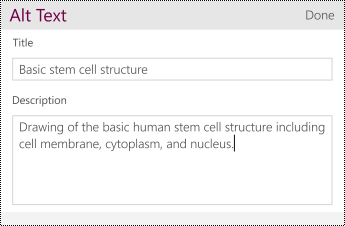
Add alternative text to tables
Adding alternative text to tables helps readers who can't see identify what the table is all about.
-
In the email you're composing, select a table.
-
To open the editing options ribbon at the bottom of the screen, tap the ... (More options) button.
-
Scroll down to the Table button, and then tap it.
-
Scroll down to the Alt Text button, and then tap it.
-
Type a description and a title.
Tip: Include the most important information in the first line, and be as concise as possible.
-
To add the text and exit the dialog, tap Done.
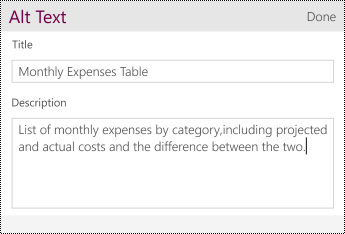
Make hyperlinks, text, and tables accessible
The following procedures describe how to make the hyperlinks, text, and tables in your Outlook email accessible.
Add hyperlink text
Add a meaningful hyperlink text to help screen reader users easily scan your email for links.
-
In the email you're composing, select the text to which you want to add the hyperlink.
-
To open the editing options ribbon at the bottom of the screen, tap the ... (More options) button.
-
Scroll down to the Insert button, and then tap it.
-
Scroll down to the Link button, and then tap it.
-
If necessary, change the hyperlink text in Text to display field.
-
In the Address text field, type the destination URL.
-
To insert the hyperlink, tap Insert.
Tip: If the title on the hyperlink's destination page gives an accurate summary of what's on the page, use it for the hyperlink text. For example, this hyperlink text matches the title on the destination page: Templates and Themes for Office Online.
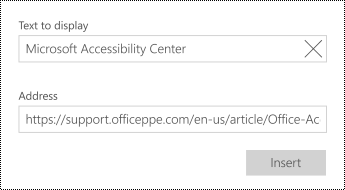
Use accessible font format
Use a familiar font type and large enough font size to help people who have dyslexia or have low vision read your email more easily.
-
In the email you're composing, select the text.
-
To open the editing options ribbon at the bottom of the screen, tap the ... (More options) button.
-
Scroll down to the Format button, and then tap it.
-
In the Format menu, select the font type, size, and formatting you want.
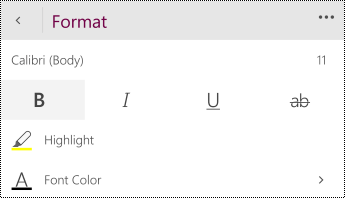
Use accessible font color
To ensure that text displays well in High Contrast mode, use the Automatic setting for font colors.
-
In the email you're composing, select the text.
-
To open the editing options ribbon at the bottom of the screen, tap the ... (More options) button.
-
Scroll down to the Format button, and then tap it.
-
In the Format menu, scroll down to the Font Color button, and then tap the > button to open the submenu.
-
In the Font Color menu, scroll down to Automatic, and then tap it.
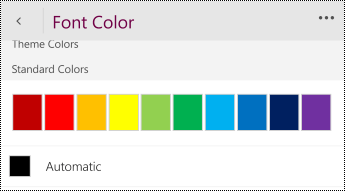
Use built-in headings and styles
The pre-designed headings and styles make it easier for screen readers to read your email.
-
Position the cursor anywhere in the email you're composing.
-
To open the editing options ribbon at the bottom of the screen, tap the ... (More options) button.
-
Scroll down to the Format button, and then tap it.
-
In the Format menu, scroll down to the Styles button, and then tap it.
-
In the Styles menu, scroll down to Heading 1 or Heading 2, and then tap it.
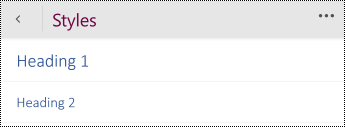
Use bulleted lists
Create bulleted lists to add structure to your text.
-
Position the cursor anywhere in the email you're composing.
-
To open the editing options ribbon at the bottom of the screen, tap the ... (More options) button.
-
Scroll down to the Format button, and then tap it.
-
In the Format menu, scroll down to the Bullets button, and then tap it.
-
In the Bullets menu, select the bullet type you want.
-
Type the text for the bulleted item. To add a new bulleted line, tap Enter on the on-screen keyboard. To end the list, press Enter twice.
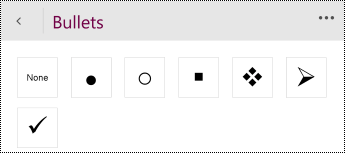
Use ordered lists
Create ordered lists to organize your text into sequential steps.
-
Position the cursor anywhere in the email you're composing.
-
To open the editing options ribbon at the bottom of the screen, tap the ... (More options) button.
-
Scroll down to the Format button, and then tap it.
-
In the Format menu, scroll down to the Numbering button, and then tap it.
-
In the Numbering menu, select the ordered list type you want.
-
Type the text for the numbered item. To add a new numbered line, tap Enter on the on-screen keyboard. To end the list, press Enter twice.
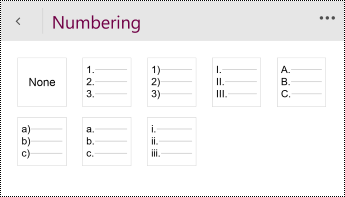
Adjust space between sentences and paragraphs
Increase or decrease white space between sentences and paragraphs.
-
In the email you're composing, select the text.
-
To open the editing options ribbon at the bottom of the screen, tap the ... (More options) button.
-
Scroll down to the Format button, and then tap it.
-
In the Format menu, scroll down to the Line & Paragraph Spacing button, and then tap it.
-
In the Line & Paragraph Spacing menu, select the line and paragraph spacing options you want.
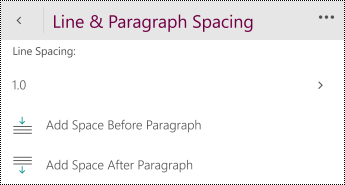
Use table headers
Specify a header row in a table.
-
In the email you're composing, position the cursor anywhere in a table.
-
To open the editing options ribbon at the bottom of the screen, tap the ... (More options) button.
-
Scroll down to the Table button, and then tap it.
-
In the Table menu, scroll down to the Style Options button, and then tap it.
-
In the Style Options menu, select the Header Row option.
-
Type column headings.
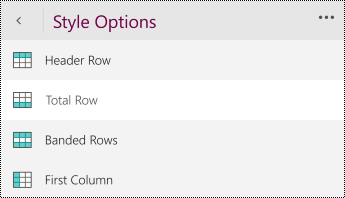
See also
Rules for the Accessibility Checker
Make your Word documents accessible
Make your PowerPoint presentations accessible to people with disabilities
Technical support for customers with disabilities
Microsoft wants to provide the best possible experience for all our customers. If you have a disability or questions related to accessibility, please contact the Microsoft Disability Answer Desk for technical assistance. The Disability Answer Desk support team is trained in using many popular assistive technologies and can offer assistance in English, Spanish, French, and American Sign Language. Please go to the Microsoft Disability Answer Desk site to find out the contact details for your region.
If you are a government, commercial, or enterprise user, please contact the enterprise Disability Answer Desk.
Hello everyone,
ReplyDeleteI will tell you a secret of getting rich on bitcoin investment “a wise person should have money in their head , but not in the heart.. Everyday is a day of new decisions. Its your choice to be rich or to be poor & keep struggling, start making larger funds in 72 hours with a legit & pro trader like me,Investment plans are open now with a minimum investment of $200 you can earn $2000 in 72 hours.
Invest $200 earn $2,000
Invest $500 earn $5,000
Invest $700 earn $7,000
Invest $1,000 earn $10,000
Invest $2,000 earn $20,000
Invest $5,000 earn $50,000
Invest $7,000 earn $70,000
Do not miss this clear opportunity to achieve your financial freedom, those who are not ready to invest now are not ready to retire early, do not depend on a single source of income, let us trade for you today and start making profit for you. Kindly contact us Via WhatsApp: +1(252)285-2093 Email : andersoncarlassettrade@gmail.com